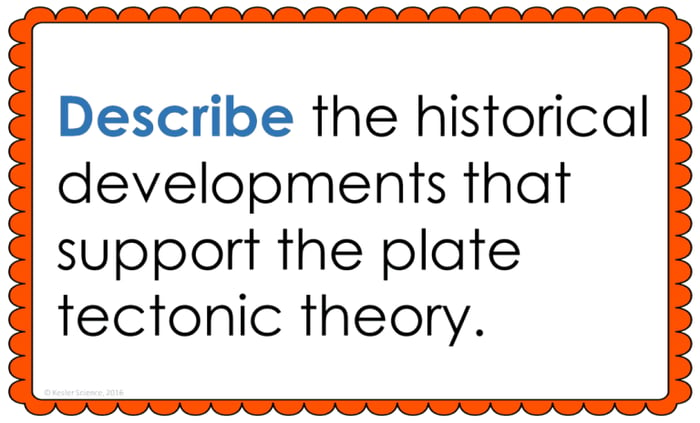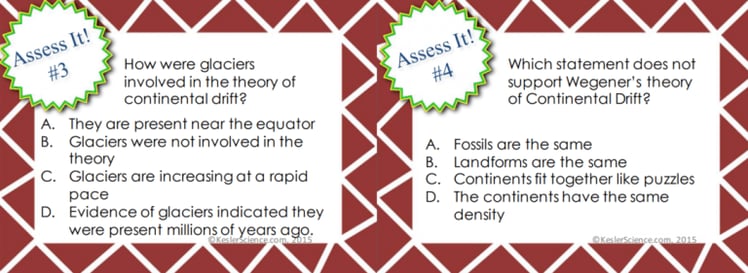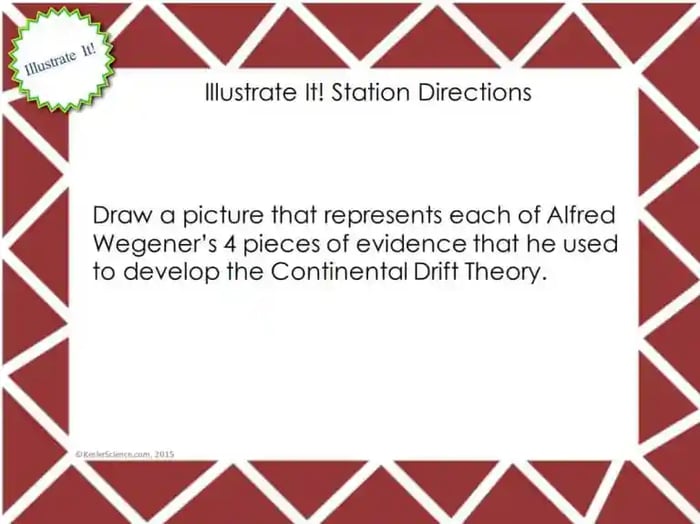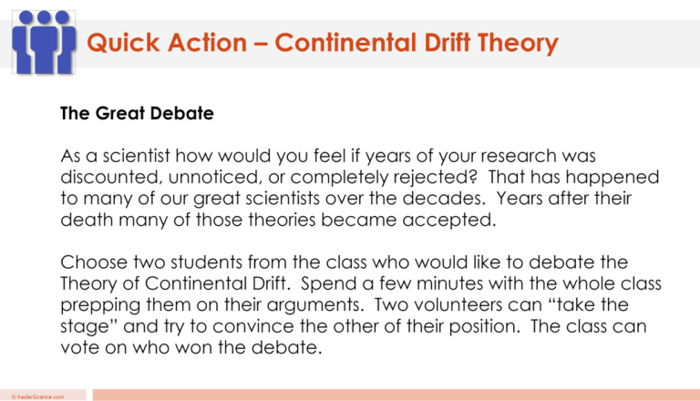 The teacher will help to clear any misconceptions about the continental drift theory. A major misconception students have is they do not realize that plates are constantly moving.
The teacher will help to clear any misconceptions about the continental drift theory. A major misconception students have is they do not realize that plates are constantly moving.
Estimated Class Time for the Engagement: 20-30 minutes
EXPLORATION
This student-centered station lab is set up so students can begin to explore continental drift theory. Four of the stations are considered input stations where students are learning new information about continental drift theory and four of the stations are output stations where students will be demonstrating their mastery of the input stations. Each of the stations is differentiated to challenge students using a different learning style. You can read more about how I set up the station labs here.
EXPLORE IT!
Students will be working in pairs to better understand continental drift theory. Students will be given blank puzzle pieces that they will try to put together in 3 minutes or less. The puzzle pieces relate to how the continents were once connected together. Students will then read information on a few task cards before trying to put another puzzle together as well, in 3 minutes or less. The second puzzle will have "clues" on each piece that will help the students. These clues relate to how Wegener discovered the possibility of a super-continent.

WATCH IT!
At this station, students will be watching a short SciShow video explaining who Alfred Wegener was and what his continental drift theory is. Students will then answer questions related to the video and record their answers on their lab station sheet. For example: What two continents did Alfred Wegener first look at and wonder if they would fit together like puzzle pieces? We often refer to the super-continent as Pangaea, but what term did Wegener use? What decade was the continental drift theory accepted by the scientific community because of the discovery of plate tectonics?
RESEARCH IT!
The research station will allow students to alter time as they watch how plate tectonics, driven by convection currents, moved the continents apart. Students will fast forward and rewind 225 million years ago to the present. Once students had enough time to see how the continents were once connected and can see how they moved apart, they can answer a few research questions that will strengthen their understanding of continental drift theory.
READ IT!
This station will provide students with a one page reading about the theory of continental drift. In the reading, students will learn about the evidence that Wegener collected that caused him to believe that the continents were once connected. There are 4 follow-up questions that the students will answer to show reading comprehension of the subject.
ASSESS IT!
The assess it station is where students will go to prove mastery over the concepts they learned in the lab. The questions are set up in a standardized format with multiple choice answers. Some questions include: Which process causes the continents to move? How do fossils of the Cynognathus, found in Africa and S. America support Wegener's theory? How were glaciers involved in the theory of continental drift? Which statement does not support Wegener's theory of Continental Drift?

WRITE IT!
Students who can answer open-ended questions about the lab truly understand the concepts that are being taught. At this station, the students will be answering three task cards like: Use the map of the world and explain which continents appear to fit together like puzzle pieces. How did Alfred Wegener use landforms to help make a case for his theory of continental drift? One thing Wegener was unable to explain before he died was why the plates moved. We know the reason now. Explain what causes the plates to move.
ILLUSTRATE IT!
Your visual students will love this station. Students will draw four images that represent each piece of evidence Wegener used to develop the Continental Drift Theory.

ORGANIZE IT!
The organize it station allows your students to organize which card represents pieces of evidence that Wegener collected for his continental drift theory.
Estimated Class Time for the Exploration: 1-2, 45 minute class periods
EXPLANATION
The explanation activities will become much more engaging for the class once they have completed the exploration station lab. During the explanation piece, the teacher will be clearing up any misconceptions about continental drift theory with an interactive PowerPoint, anchor charts, and interactive notebook activities. The continental drift theory lesson includes a PowerPoint with activities scattered throughout to keep the students engaged.

The students will also be interacting with their journals using INB templates for continental drift theory. Each INB activity is designed to help students compartmentalize information for a greater understanding of the concept. The continental drift theory INB template allows students to focus their notes on Alfred Wegener, Continental Drift Theory, Pangaea, and the 3 pieces of evidence.
Estimated Class Time for the Exploration: 2-3, 45 minute class periods
ELABORATION
The elaboration section of the 5E method of instruction is intended to give students choice on how they can prove mastery of the concept. When students are given choice the ‘buy-in’ is much greater than when the teacher tells them the project they will have to create. The elaboration project will allow students to create a presentation to teach about continental drift theory.Estimated Class Time for the Elaboration: 2-3, 45 minute class periods (can also be used as an at-home project)
EVALUATION
The final piece of the 5E model is to evaluate student comprehension. Included in every 5E lesson is a homework assignment, assessment, and modified assessment. Research has shown that homework needs to be meaningful and applicable to real-world activities in order to be effective. When possible, I like to give open-ended assessments to truly gauge the student’s comprehension.
Estimated Class Time for the Elaboration: 1, 45 minute class period
DOWNLOAD THE FULL LESSON NOW
The full lesson is available for download from the Kesler Science Store. Save yourself a ton of time and grab it now.





